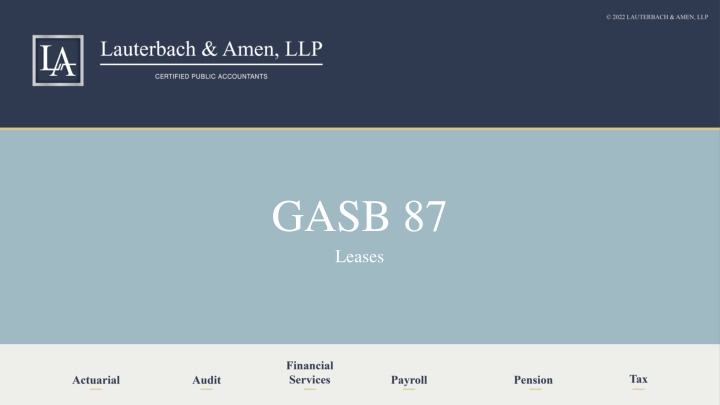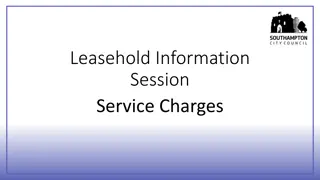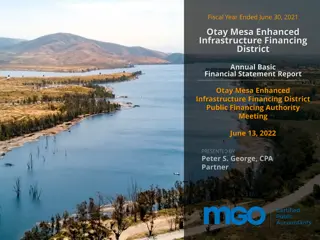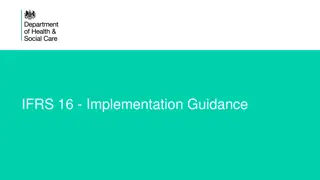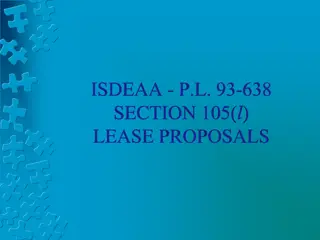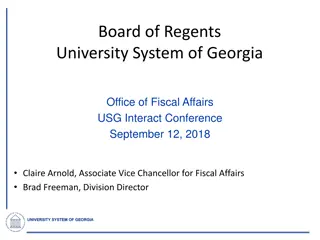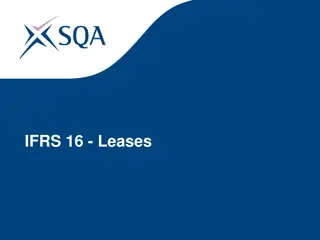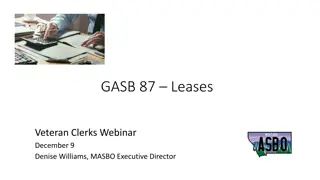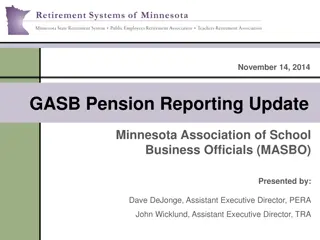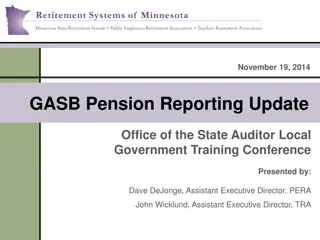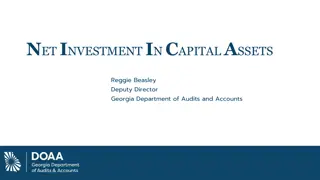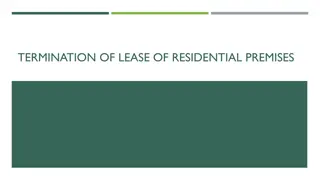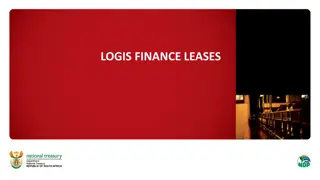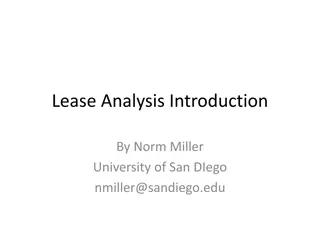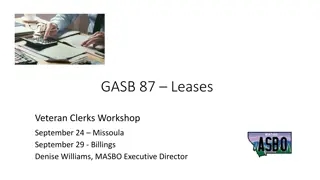GASB 87 Leases Overview: Changes in Lease Reporting
GASB 87 introduces a new approach to lease reporting, categorizing leases into short-term, ownership-transferring contracts, and general leases. This shift impacts lease recognition, measurement, and disclosure requirements for both lessees and lessors. Effective after June 15, 2021, organizations must identify, gather data, and prepare for implementation following specific steps outlined by GASB. The distinction between operating and capital leases is replaced by the three new lease categories. With examples, definitions, and accounting implications detailed, organizations must adapt to the revised standards by the stipulated effective dates.
Download Presentation

Please find below an Image/Link to download the presentation.
The content on the website is provided AS IS for your information and personal use only. It may not be sold, licensed, or shared on other websites without obtaining consent from the author.If you encounter any issues during the download, it is possible that the publisher has removed the file from their server.
You are allowed to download the files provided on this website for personal or commercial use, subject to the condition that they are used lawfully. All files are the property of their respective owners.
The content on the website is provided AS IS for your information and personal use only. It may not be sold, licensed, or shared on other websites without obtaining consent from the author.
E N D
Presentation Transcript
GASB 87 Leases
Overview GASB approached this new statement with the philosophy that a lease is a form of financing, and should be reported as such Eliminates the current (2) categories of leases (capital and operating) and creates (3) categories of leases (short-term, contracts that transfer ownership, and all other leases) The new statement will change how we recognize leases, how we measure them, and the required disclosures depending on the category of lease Applies to both the lessee and the lessor 2
Now effective for periods beginning after June 15, 2021 Effective Dates June 30, 2022 December 31, 2022 April 30, 2023 3
Implementation Steps 1) Identify all leases (lessee and lessor perspective both applicable) 2) Gather data: lease agreements, payment terms, interest rate, etc. Identify the type of lease Identify required recording of the lease depending on type Identify the required disclosures for the lease depending on type 3) Prepare for implementation
No more operating vs. capital leases No 4 factor test to see if it meets a capital lease 1) Short-Term Leases 3 New Categories of Leases 2) Contracts that Transfer Ownership 3) All Other Leases 5
1) Short-Term Leases Definition: A lease with a term of 12 months or less Accounting: Lessee: Expense Lessor: Revenue Disclosure: None required 6
2) Contracts that Transfer Ownership Definition: The underlying asset transfers ownership at the end of the term of the lease Accounting: Lessee: Is a financed purchase of an asset (loan) Lessor: Is a sale of an asset Disclosure: Lessee: Typical capital asset and loan disclosures Lessor: Typical sale of an asset disclosures 7
3) All Other Leases (Target of GASB 87) Definition: Aren t short-term and don t transfer ownership at the end of the term of the lease Accounting: Lessee: Lease Asset/Lease Liability Lessor: Lease Receivable/Deferred Inflow of Lease Revenues Disclosure: Lessee: Yes Lessor: Yes 8
More on All Other Leases For Lessees: At lease commencement, lessee will recognize a lease liability and an intangible right-to-use lease asset (lease asset) Lease Liability measured at the PV of future lease payments. Payments will reduce the liability. Will also recognize lease interest expense at time of repayment. Lease Asset initially equals the lease liability. Will be amortized over the shorter of the lease term or the useful life of the underlying asset. 9
More on All Other Leases For Lessors: At lease commencement, lessee will recognize a lease receivable and a deferred inflow of resources related to the lease (deferred lease revenue) Lease Receivable measured at the PV of future lease payments (same as lessee s lease liability). Payments will reduce the receivable. Will also recognize lease interest revenue at time of repayment. Deferred Lease Revenue initially equals the lease receivable. Inflows of resources (revenue) will be recognized as payments are made. Amortized over the lease term (straight line). * Note: the Lessor still owns the asset and should continue to report the underlying asset and depreciate the asset, as applicable 10
Start of the Lease - Recording in Governmental Funds Debit Capital Outlay (Expenditure) $XXX,XXX Credit Lease Proceeds (Other Financing Source) $XXX,XXX All Other Leases - Lessee Start of the Lease - Government-Wide Conversion Debit Lease Proceeds (Other Financing Source) $XXX,XXX Credit Lease Payable (Liability) $XXX,XXX Debit Lease Asset (Intangible Asset) $XXX,XXX Credit Capital Outlay (Expenditure) $XXX,XXX 11
Payments Made in Governmental Funds Debit Principal (Expenditure) Debit Interest (Expenditure) $X,XXX Credit Cash $X,XXX $X,XXX All Other Leases - Lessee Payments Made in Government-Wide Conversion Debit Lease Payable (Liability) for principal Credit Principal (Expenditure) $X,XXX Debit Amortization (Expense) Credit Lease Asset (Intangible Asset) $X,XXX $X,XXX $X,XXX Lessor will report basically the opposite of the transactions above 12
All Other Leases - Lessor Start of the Lease - Recording in Governmental Funds Debit Lease Receivable (Asset) $XXX,XXX Credit Deferred Inflow of Resources $XXX,XXX Start of the Lease - Government-Wide Conversion No adjustment for commencement of lease in the government-wide statements 13
All Other Leases - Lessor Payments Received in Governmental Funds Debit Cash Credit Lease Receivable (Asset) Credit Interest (Revenue) Debit Deferred Inflows of Resources Credit Lease Revenue Depreciating the Asset Owned by the Lessor $X,XXX $X,XXX $X,XXX $X,XXX $X,XXX Debit Depreciation Expense Credit Accumulated Depreciation $X,XXX $X,XXX 14
All Other Leases - Disclosure Requirements Changes required to the footnotes for both lessees and lessors Lessee Description of the leases Total lease assets recognized Schedule of future lease payments (principal and interest) Lessor Description of leasing arrangement Amount of lease revenue recognized in the year 15
Other Considerations Begin planning to review existing lease agreements Confirm any that you are the Lessee Also confirm any that you are the Lessor Apply materiality please no recording of minor copier leases under this new statement Remember: the statement does not apply to short-term leases or those that are ownership transfer contracts, which is really just a financed asset acquisition 16
Questions??? Lauterbach & Amen, LLP 630.393.1483 Phone Jamie L. Wilkey, Partner jwilkey@lauterbachamen.com Tim Gavin, Principal tgavin@lauterbachamen.com 17
